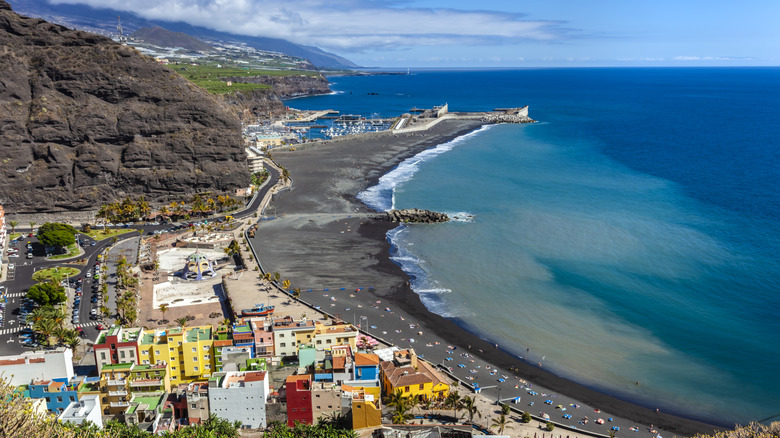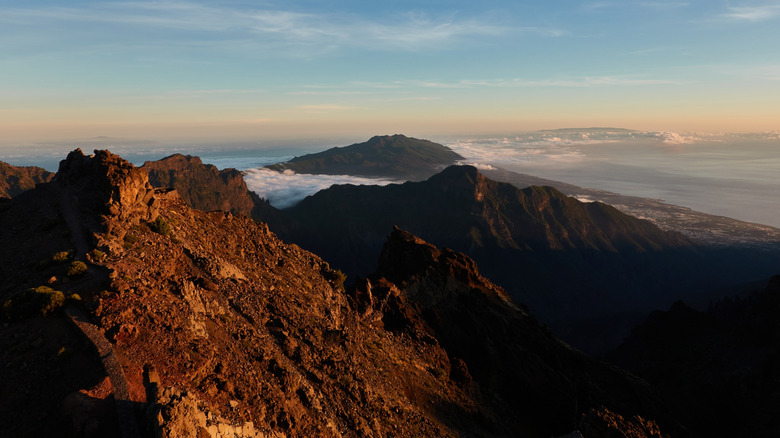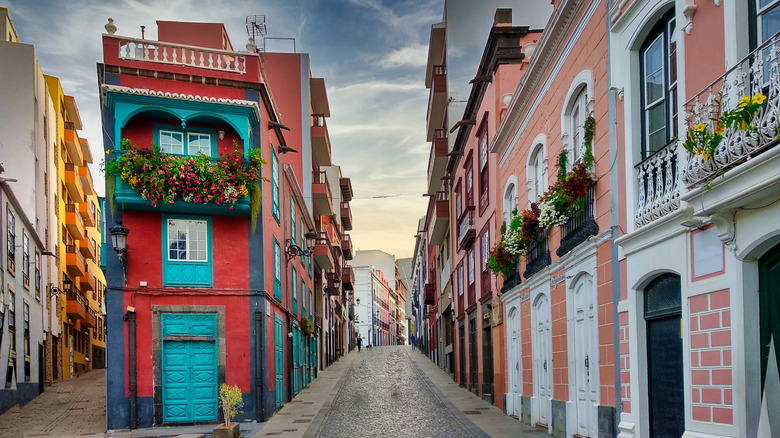Spain's Astonishing Island Destination Is Fringed By Black Volcanic Beaches And Pristine Seas
Floating in pristine seas off the northwestern coast of Africa are Spain's magical Canary Islands. This jewel-like archipelago comprising eight islands is awash in Spanish culture, rich history, and dramatic volcanic landscapes. Undeniably among Spain's most beautiful islands, the Canary Islands emerged from the ocean floor millions of years ago owing to underwater volcanic eruptions. The oldest islands in the chain, Fuerteventura and Lanzarote, were formed 20 to 30 million years ago. At roughly 2 to 3 million years old, the youngest island is La Palma, an astonishing destination fringed by black volcanic beaches. Incredibly, it remains one of the archipelago's most volcanically active islands, as evidenced by the 2021 eruption of the Cumbre Vieja volcano.
Fondly known as La Isla Bonita, or "the beautiful island" in English, La Palma's excellent weather makes it an ideal escape any time of year. This sunny paradise boasts average temperatures of 71 degrees Fahrenheit year-round and the lowest rainfall of all the islands. La Palma's Mediterranean climate combined with its ancient volcanic soil have blanketed the island's striking geological formations in stunning and unique biodiversity. In 2022, UNESCO designated the entire island a World Biosphere Reserve. The UNESCO distinction also recognizes La Palma as a model for sustainable development.
Naturally, La Palma is an ecotourism dream, sporting no shortage of awe-inspiring, protected areas. Among these are the La Palma Island Marine Reserve, which abounds with creatures like loggerhead turtles and bottlenose dolphins as well as invertebrates, tropical anemones, and other mystifying sea life. Several monuments, landscapes, and bird habitats are protected as part of the Natura 2000 Network, a collective of prominent ecological sites in Europe overseen by the European Union.
La Palma teems with unmissable, surreal natural wonders
La Palma is one of Europe's most striking volcanic regions. Visitors can't miss the surreal Cumbre Vieja National Park, an otherworldly landscape of dense pine forests, volcanic peaks, and thick black plots of prehistoric lava. The park is enormous, slicing across the center of the island through five municipalities. Trek solo through Cumbre Vieja along its "volcanic route," or take a guided tour showcasing the Cumbre Vieja volcano, which devastated several nearby towns in 2021 after spewing lava for an unfathomable 85 days. Teneguía Volcanoes Natural Monument is another essential visit. You'll feast your eyes on the San Antonio volcano, which last erupted in the 17th century, and the eponymous Teneguía volcano, the last volcano to erupt on La Palma before the Cumbre Vieja volcano.
The 18-square-mile Caldera de Taburiente National Park, La Palma's most visited attraction, is a rugged symphony of pine forests, peaceful streams, and cascading waterfalls, all surrounded by massive, jagged mountain peaks. The landscape resides inside a deep crater that was formed after volcanic structures collapsed after their magma was drained. One Tripadvisor review rhapsodizes: "This is really the most beautiful thing I've seen on La Palma."
From bustling ocean fronts to coastal coves, La Palma's volcanic, black sand beaches will take your breath away. For a stellar experience, visit the island's Blue Flag beaches, which bear a prestigious, international environmental distinction for cleanliness and safety. On La Palma's east side, you'll find Blue Flag waters at Playa de los Cancajos and Playa de Bajamar, which is near the island's pretty capital of Santa Cruz de La Palma. On the west side, don't miss tranquil, family-friendly Playa del Charco Verde or Playa de Puerto Naos, La Palma's largest beach.
Step into La Palma's rich history in the colorful, colonial capital of Santa Cruz de la Palma
Admire La Palma's rich history with a stroll through the charming cobblestone streets of Santa Cruz de la Palma. Founded in 1493, the island's colorful capital is enlivened with beautiful colonial architecture reflecting its halcyon days as Spain's first headquarters for the Council of the Indies, a group of royal appointees who convened here in governance of Spain's colonies.
The old town is anchored around the pretty Plaza de España, where majestic churches, buildings, and museums are the most alluring attractions. The Church of San Francisco is built in the Renaissance style and brims with Flemish artwork inside. The 16th-century Town Hall is filled with lovely frescoes, while the imposing, stone Casa Principal de Salazar invites visitors inside the home of a Knight of the Order of Calatrava. Museo Insular de la Palma, located inside a former Franciscan convent, is the island's crowning cultural achievement. Here you'll discover a fine collection of Spanish paintings alongside fascinating photography, nature, and history exhibitions. Outside the Naval Museum, a splendid replica of Christopher Columbus' famous ship the Santa Maria is on display. Be sure to trek slightly farther afield to see the a revered statue of the island's patron saint inside the Shrine of the Virgin of Las Nieves.
Once you're in Spain, you can easily reach La Palma via direct flights from Madrid and Barcelona to La Palma Airport. There are also direct flights to La Palma from several popular European destinations, including Amsterdam, London, Zurich, and Berlin. Alternatively, you can arrive on La Palma's beguiling black shores by cruise ship, which is the best way to see the Canary Islands.


